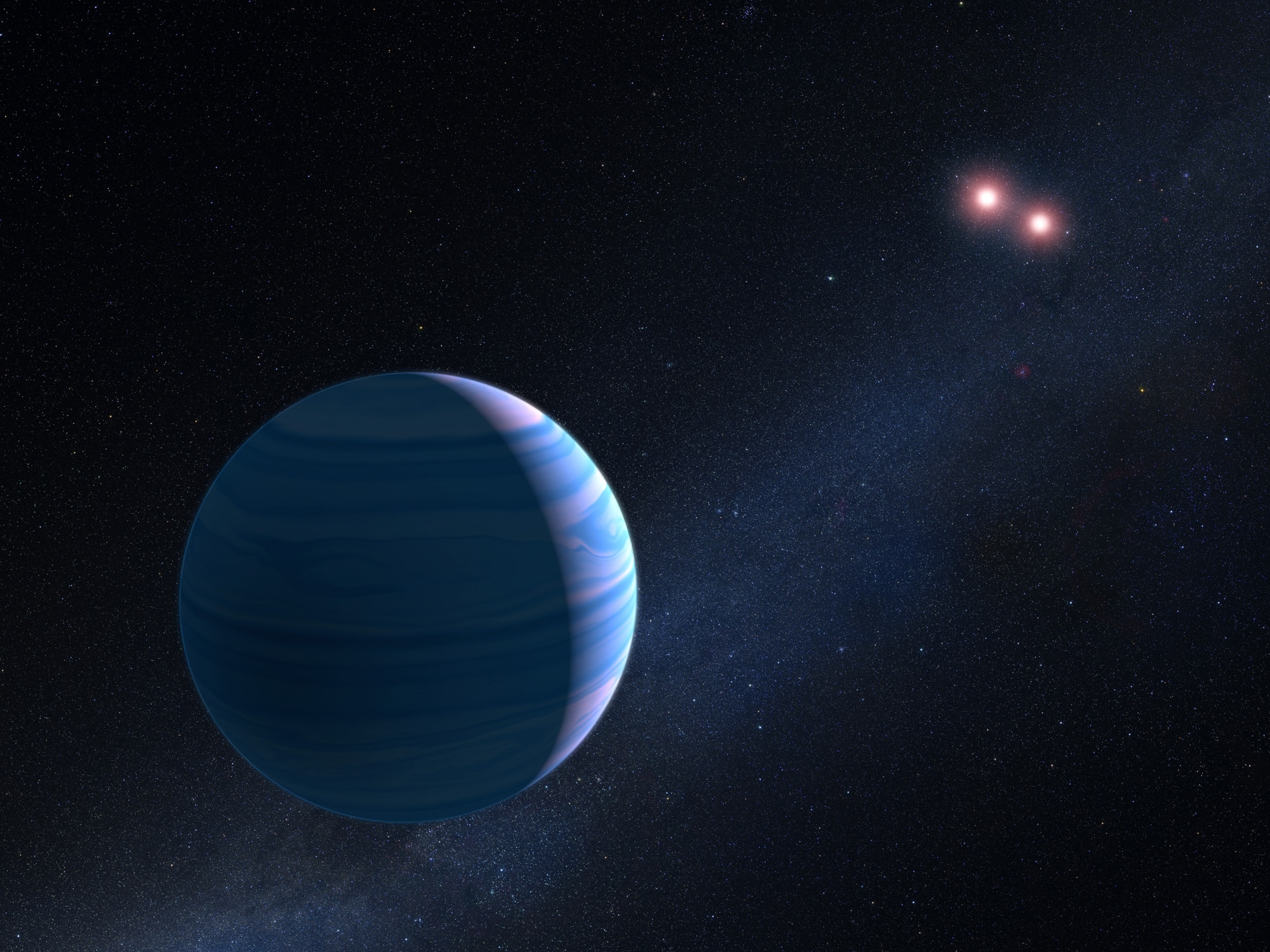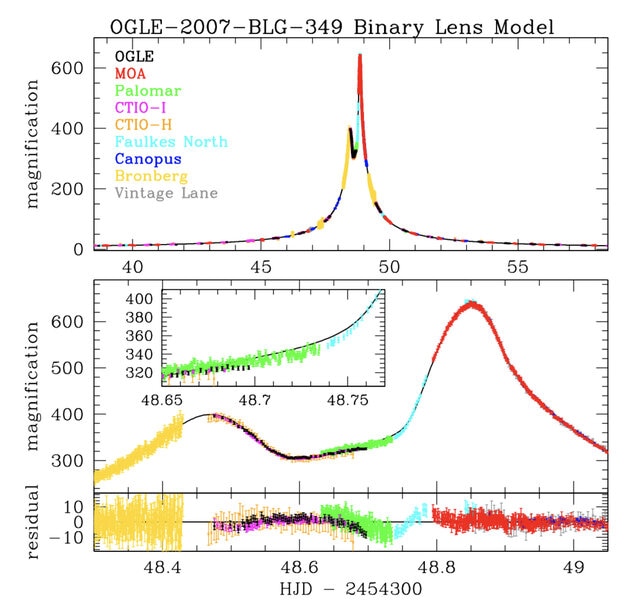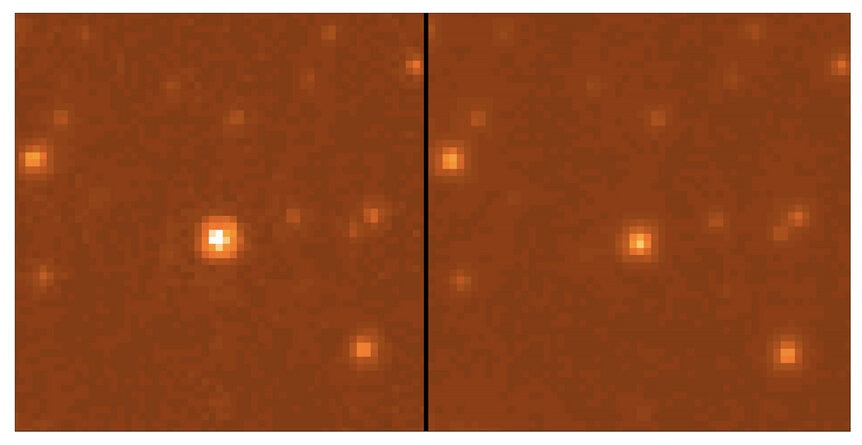Create a free profile to get unlimited access to exclusive videos, sweepstakes, and more!
Gravity betrays the presence of a planet orbiting a binary star 10,000 light years from Earth

Astronomers have discovered an exoplanet, a planet orbiting an alien star.
That by itself would've been news just a few years ago, but given that we’ve found thousands of exoplanets, there has to be more. And there is! It’s orbiting a binary star, a pair of stars orbiting each other. Since it orbits both, it’s called a circumbinary exoplanet.
But those have been found before too! So what makes this one special? It’s how it was found. And that’s a bit of a tale.
The planet is called — are you ready for this? — OGLE-2007-BLG-349L(AB)b. There’s a lot in that name, and unpacking it tells you how it was found, so bear with me.
OGLE stands for the Optical Gravitational Lensing Experiment. This project is actually designed to look for dark matter. We know dark matter exists, but we’re not sure what it is. On the assumption (now probably outdated) that it might be lots of dark objects like rogue planets, black holes, and dead stars, OGLE stares at regions of the sky thick with stars. If one of these dark objects passes almost exactly between us and one of those stars, a funny thing can happen: The background star gets brighter.
This is because gravity bends space, and that means the path light takes to get here from the background star gets distorted. This is called gravitational lensing, and a lot of very odd effects can come from this, one of which is that the background star can have its light focused by the lensing object, making it appear brighter.
So OGLE looks for this brightening, which can take many days as the motion of the three objects (the distant star, or lensed object; the intervening object, or lens; and us: Earth) moves them into and then out of alignment. Mind you, any massive object can act as a lens: a black hole, a dead star, or even a perfectly normal star and/or a planet orbiting it. It’s the gravity that does the work.
In 2007 one such brightening occurred (hence the number in the planet’s name). Astronomers were alerted, and many telescopes were pointed toward the star. The star was located near the center of our Milky Way Galaxy, where there is a swarm of stars forming a spherical bulge — that’s the BLG in the planet’s name. It was the 349th lens found toward the bulge, so that’s the 349L.
But right away the astronomers saw something odd. There were two brightening events, not one. That meant the lens was actually two objects, perhaps a star and a planet! OGLE had already found several planets orbiting stars this way; it’s an added bonus of the project.
But when astronomers took the data and applied their physical models to it, basically using the equations of gravitational lenses (based, I’ll note, on Einstein’s relativity physics), they found they don’t quite fit. A small twist in the middle of the light curve (the plot showing the change in brightness over time) showed that this wasn’t a pair of objects, like a star and planet: It was a trio! It was either a star with two planets orbiting it, or a pair of stars orbiting each other with a planet orbiting both.
The models indicated the total mass of the lensing system was about 0.7 times the Sun’s mass — so if it were a single star it’d be cooler and dimmer than the Sun, but if it were two stars sharing that mass then both were much cooler and much dimmer. The problem was, the models couldn’t distinguish between the two scenarios. Both fit the data pretty well. So what to do?
Enter Hubble. Astronomers were able to snag time on the orbiting telescope to observe the lensing event, and caught the tail end of it in 2007 and 2008. The lensed star was still fading in 2007 during the first observation, but by 2008 it was essentially over.
Even Hubble couldn’t spatially separate out the lensing trio from the background lensed star (they were aligned so closely together in the images they look like one object), but it could do something else: measure not just the brightness of the objects but also their colors during and after the event.
That’s critical. A single star with 0.7 times the Sun’s mass would be redder than the Sun, kinda orange, but two stars of, say, 0.35 times the Sun’s mass each would be far redder.
And Hubble found the color of the lens was very red. That meant it was two stars: A binary. Once that was known and put into the models, the other lensing object was found to be a planet orbiting both: a circumbinary exoplanet.
And now, finally, we can get some numbers to go with all this. The background (lensed) star is probably located near the center of the galaxy, about 25,000 light-years away. That puts the binary and planet about 10,000 light-years from Earth.
The two stars in the binary are indeed dinky red dwarfs, with about 0.4 and 0.3 times the mass of the Sun. They orbit each other about once every 10 days, and are about 12 million kilometers apart (that’s a decently tight orbit; Mercury is roughly 60 million km from the Sun).
The planet has about 80 times the mass of the Earth. That’s nearly the mass of Saturn (which is 95 times the Earth’s mass), so it’s likely this planet is a small gas giant. It orbits the pair very roughly 500 million kilometers out, taking about 7 years to do so … and that’s interesting, too. If a circumbinary planet orbits too closely to the stars, the orbit can become unstable; the changing gravity it feels from each star will be enough to disrupt the orbit. Almost all circumbinary planets found orbit very close to this limit. This one, though, orbits pretty far out, well into the stable zone.
Under the usual methods of finding planets — the transit method, for example — planets closer in to their stars are easier to find, so that’s what we see. OGLE doesn’t discriminate that way; it finds farther-out planets just as well. So it’s possible that circumbinary planets on wide orbits are common, but it’s just that we don’t see them as easily.
Right away, that makes this planet important. Half the stars in the galaxy are in binary systems, so planets like this could possibly be as common as planets like ours! That’s pretty cool.
One last thing: That letter at the end of the name. In general, exoplanets are given the star’s name plus a lowercase b at the end. In general, the two stars in a binary are called (capital) A and B, in order of their brightness. This planet orbits both, so we get OGLE-2007-BLG-349L(AB)b. Unwieldy, but informative if you can read the code.
However, the discovery paper itself calls the planet c, not b. They say that they did this to avoid an inconsistency in the naming convention for planets in binary systems, by using a unique letter for each object. I have to say, though, I disagree.
Exoplanets are given letter designations in order of their discovery, starting with a lowercase b and moving from there. The lowercase a is skipped, because sometimes that’s used to refer to the star. That’s a bit odd, I’ll admit, but it’s the rule, and it’s consistent.
For our circumbinary planet here, the use of a lowercase b works if the stars are listed in parentheses, making it clear it’s a circumbinary. If it only orbited star A, we’d call the planet OGLE-2007-BLG-349LAb. This can get a little hard to read, but it’s still consistent, and it’s not hard to get used to. Better, it makes it easy to decipher if you break it down.
Calling this planet c is inconsistent with other exoplanet designations, making it seem like this is the second planet found in the system. So I prefer b.
Normally I’m not so concerned about the naming of names, but in reality we’re discovering these planets so rapidly that we need a consistent naming orthodoxy before matters get too messy.
And don't let it overshadow the planet itself! This was a very cool discovery, and it strongly implies we'll be finding more of these using gravitational lensing the more we look. OGLE's been going since 1992, and it looks like it'll keep staring at stars for the foreseeable future.
I'm all for it. Why let Kepler have all the fun?




























